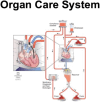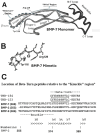Cardiac preservation using ex vivo organ perfusion: new therapies for the treatment of heart failure by harnessing the power of growth factors using BMP mimetics like THR-184
- PMID: 40171539
- PMCID: PMC11960666
- DOI: 10.3389/fcvm.2025.1535778
Cardiac preservation using ex vivo organ perfusion: new therapies for the treatment of heart failure by harnessing the power of growth factors using BMP mimetics like THR-184
Abstract
As heart transplantation continues to be the gold standard therapy for end-stage heart failure, the imbalance between the supply of hearts, and the demand for them, continues to get worse. In the US alone, with less than 4,000 hearts suitable for transplant and over 100,000 potential recipients, this therapy is only available to a very few. The use of hearts Donated after Circulatory Death (DCD) and Donation after Brain Death (DBD) using ex vivo machine perfusion (EVMP) is a promising approach that has already increased the availability of suitable organs for heart transplantation. EVMP offers the promise of enabling the expansion of the overall number of heart transplants and lower rates of early graft dysfunction. These are realized through (1) safe extension of the time between procurement and transplantation and (2) ex vivo assessment of preserved hearts. Notably, ex vivo perfusion has facilitated the donation of DCD hearts and improved the success of transplantation. Nevertheless, DCD hearts suffer from serious preharvest ischemia/reperfusion injury (IRI). Despite these developments, only 40% of hearts offered for transplantation can be utilized. These devices do offer an opportunity to evaluate donor hearts for transplantation, resuscitate organs previously deemed unsuitable for transplantation, and provide a platform for the development of novel therapeutics to limit cardiac injury. Bone Morphogenetic Protein (BMP) signaling is a new target which holds the potential for ameliorating myocardial IRI. Recent studies have demonstrated that BMP signaling has a significant role in blocking the deleterious effects of injury to the heart. We have designed novel small peptide BMP mimetics that act via activin receptor-like kinase (ALK3), a type I BMP receptor. They are capable of (1) inhibiting inflammation and apoptosis, (2) blocking/reversing the epithelial-mesenchymal transition (EMT) and fibrosis, and (3) promoting tissue regeneration. In this review, we explore the promise that novel therapeutics, including these BMP mimetics, offer for the protection of hearts against myocardial injury during ex vivo transportation for cardiac transplantation. This protection represents a significant advance and a promising ex vivo therapeutic approach to expanding the donor pool by increasing the number of transplantable hearts.
Keywords: BMP; Bone morphogenetic protein; Ex-vivo heart machine perfusion; NMP; TGF; THR-123; THR-184; mimetics.
© 2025 Carlson, Bosukonda, Keck, Bey, Tessier and Carlson.
Conflict of interest statement
The authors declare that the research was conducted in the absence of any commercial or financial relationships that could be construed as a potential conflict of interest. The author(s) declared that they were an editorial board member of Frontiers, at the time of submission. This had no impact on the peer review process and the final decision.
Figures








Similar articles
-
Normothermic ex vivo Heart Perfusion Combined With Melatonin Enhances Myocardial Protection in Rat Donation After Circulatory Death Hearts via Inhibiting NLRP3 Inflammasome-Mediated Pyroptosis.Front Cell Dev Biol. 2021 Aug 31;9:733183. doi: 10.3389/fcell.2021.733183. eCollection 2021. Front Cell Dev Biol. 2021. PMID: 34532321 Free PMC article.
-
Portable Normothermic Cardiac Perfusion System in Donation After Cardiocirculatory Death: A Health Technology Assessment.Ont Health Technol Assess Ser. 2020 Mar 6;20(3):1-90. eCollection 2020. Ont Health Technol Assess Ser. 2020. PMID: 32190164 Free PMC article.
-
Transplantation of Hearts Donated after Circulatory Death.Front Cardiovasc Med. 2018 Feb 13;5:8. doi: 10.3389/fcvm.2018.00008. eCollection 2018. Front Cardiovasc Med. 2018. PMID: 29487855 Free PMC article. Review.
-
Normothermic ex vivo heart perfusion with NLRP3 inflammasome inhibitor Mcc950 treatment improves cardiac function of circulatory death hearts after transplantation.Front Cardiovasc Med. 2023 Mar 17;10:1126391. doi: 10.3389/fcvm.2023.1126391. eCollection 2023. Front Cardiovasc Med. 2023. PMID: 37008319 Free PMC article.
-
Machine perfusion of circulatory determined death hearts: A scoping review.Transplant Rev (Orlando). 2020 Jul;34(3):100551. doi: 10.1016/j.trre.2020.100551. Epub 2020 May 12. Transplant Rev (Orlando). 2020. PMID: 32498975
References
LinkOut - more resources
Full Text Sources
Research Materials

